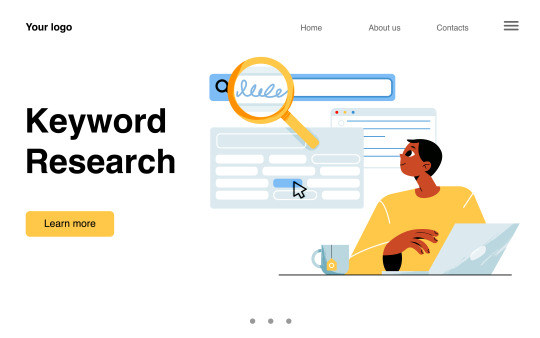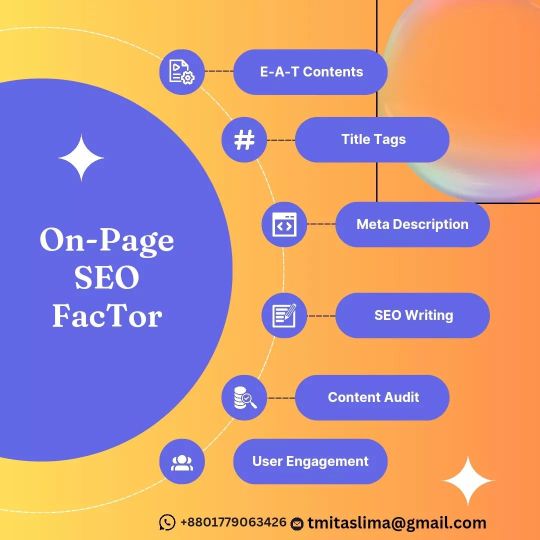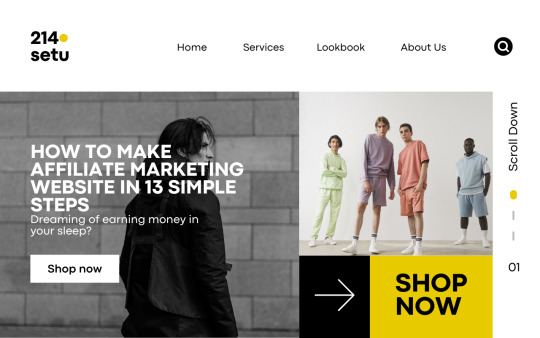#Keyword Strategies
Explore tagged Tumblr posts
Text

Dog came up in the middle of me using dictation software to draft notes for a presentation
#grad school#turns out she thought the keywords were 'pet me' and 'couch cuddles'#it was not a very good search strategy but it did yield positive results#Kayt.txt
12 notes
·
View notes
Text
Best SEO Practices 2025: The Ultimate Guide to Ranking Higher
Table of Contents Introduction Why SEO is Important in 2025 Top SEO Trends for 2025 Core SEO Strategies for Higher Rankings Content Optimization for 2025 Technical SEO Best Practices Link Building and Off-Page SEO Mobile and Voice Search Optimization AI and Automation in SEO User Experience (UX) and Core Web Vitals Experiments and Case Studies FAQs People Also Ask (PAA) Knowledge…
#AI in SEO#AI-driven SEO#Best SEO practices 2025#content optimization#Core Web Vitals#Digital Marketing Strategy#digital-marketing#E-E-A-T#Featured Snippets#Google ranking factors#keyword-research#link building#local SEO#Marketing#mobile SEO#off-page SEO#on-page SEO#organic traffic growth#organic-traffic#page experience#Search Engine Optimization#seo#SEO Case Study#SEO Trends 2025#SERP optimization.#structured data#technical SEO#user experience#voice search SEO#website ranking
2 notes
·
View notes
Text
The Relevance of Conducting Keyword Research in Digital Marketing
In a world dominated by technology where businesses require visibility to succeed. The only way to cut through the noise of millions of websites is to know what your audience wants, and then create content that addresses that need. This is where conducting keyword research comes in- it is a critical building block that goes into constructing a good digital marketing strategy.
Understanding Keyword Research :
In most cases, users do not type in full sentences into search engines- instead, they search for keywords and phrases. Keywords are what connect the questions asked by the user, to a piece of content prepared to answer the query. Identifying keywords allows businesses to create content that users are looking for, increasing their chances of ranking higher in search results, and making more sales.

Why Is Keyword Research Important?
A Better Return On Investment (ROI): Returning from targeted ads is higher than any other form or investing in advertising channels, for example: Pay per click adverts.
Increased Visibility: It is extremely hard to get noticed as a new website, and investing in keywords will allow you to boost your website’s organic traffic.
Understanding Audience Intent: Good keyword research helps you understand what your target audience is looking for and how they phrase their queries. You can, therefore, create content that directly answers their needs, thus building trust and fostering engagement.
3. Competitive Advantage: Analyze the keywords your competitors are targeting, find gaps in their strategy, and identify opportunities to differentiate your content. This way, you are ahead in a crowded marketplace.
4. Cost-Efficient Advertising: Keyword research for paid campaigns is very important. For example, Google Ads has to be able to select appropriate cost-effective, high-performing keywords. So, targeting the right keywords really minimizes waste and maximizes ROI.
5. Content Strategy Development: It acts as a roadmap for content strategy. By creating blog posts, videos, and other such assets that actually resonate with the audience while satisfying the search engines, it provides a well-researched list of keywords.
Effective Keyword Research Tips
Use Tools: Utilize Google Keyword Planner, SEMrush, or Ahrefs to uncover the volume, competition, and trend of your keyword.
Long Tail Keywords: Be more specific as they tend to have less competition and more chances of conversion
Search Intent: Identify if it is an information intent, a navigational intent, or transactional intent to use it appropriately for your content.
Keep fresh: trends in searches change, and your keyword approach should be reviewed regularly.
Keyword research is far from a technical task; it's a strategic initiative that bestows business the power to connect with audiences more effectively. The time and resources you invest in understanding the language of your customers set you up for long-term digital marketing success. Whether you are optimizing for organic search or planning a PPC campaign, keyword research is the compass guiding your efforts toward measurable results.
#Digital Marketing#SEO Strategy#Search Engine Optimization#Audience Intent#Content Marketing#PPC Campaigns#Long-Tail Keywords#Marketing Tips#Competitive Analysis#Online Advertising#Marketing Strategy#Website Traffic#Organic Search#Digital Marketing Trends#Keyword research#keyword research tools
2 notes
·
View notes
Text
How to Create Designs That Work for Your Print-on-Demand Business
Running a print-on-demand business is both exciting and challenging. Whether you're selling on platforms like Redbubble or managing your own store, creating designs that resonate with your audience is the key to success. But how do you craft designs that not only look great but also sell? In this blog post, I’ll guide you through the process of creating designs that work for your print-on-demand business, with tips and tricks tailored to help you stand out in a competitive market. Let’s dive in!
Why Design Matters in Print-on-Demand
In the world of print-on-demand, your designs are your product. Unlike traditional retail, you’re not selling physical inventory—you’re selling ideas. Your customers are drawn to your creativity, so your designs need to:
- Capture attention: Bold, unique designs stand out in search results.
- Resonate with your audience: People buy designs that align with their personality, values, or interests.
- Fit the product: A design that looks great on a t-shirt might not work on a mug or phone case.
Understanding these principles is the first step to creating designs that work for your business.
Step 1: Know Your Niche
The most successful print-on-demand businesses are niche-focused. Instead of trying to appeal to everyone, target a specific audience.
- Research your audience: Who are they? What are their interests, hobbies, or values?
- Find trending niches: Use tools like Google Trends or Redbubble’s trending searches to discover what’s popular.
- Create for your passion: If you’re passionate about your niche, it will show in your designs.
For example, if your niche is cozy, minimalist designs, you could create products that appeal to people who love hygge-inspired aesthetics.
Step 2: Brainstorm Unique Design Ideas
Once you’ve identified your niche, it’s time to brainstorm ideas. Here’s how to get started:
- Use keyword research: Tools like Redbubble’s search bar or Pinterest Trends can help you find popular themes.
- Look for inspiration: Check out competitors, social media, or even nature for fresh ideas.
- Think seasonally: Holidays, seasons, and special events are great opportunities for themed designs.
Pro tip: Keep a notebook or digital folder for design ideas. Inspiration can strike at any time!
Step 3: Master the Tools of the Trade
You don’t need to be a professional graphic designer to create stunning designs. With the right tools, anyone can make high-quality artwork.
- Free design tools: Canva, GIMP, and Inkscape are great for beginners.
- Professional software: Adobe Photoshop and Illustrator offer advanced features for experienced designers.
- Mockup generators: Use tools like Placeit to see how your designs will look on products.
If you’re new to design, start simple. Minimalist designs with clean lines and bold typography are often bestsellers.
Step 4: Optimize Your Designs for Products
Not all designs work on every product. To maximize sales, tailor your designs to fit specific items.
- Consider placement: A design that looks great on a t-shirt might need adjustments for a mug or sticker.
- Use high-resolution files: Print-on-demand platforms require high-quality images to ensure sharp prints.
- Test your designs: Upload them to mockup tools to see how they look on different products.
For example, if you’re creating a design for a phone case, make sure the key elements aren’t cut off by the edges or camera hole.
Step 5: Write SEO-Friendly Titles and Tags
Even the best designs won’t sell if no one can find them. That’s where SEO comes in.
- Use relevant keywords: Include terms your audience is searching for, like “minimalist phone case” or “funny coffee mug.”
- Write descriptive titles: Instead of “Cool Design,” try “Retro Sunset Design for T-Shirts and Stickers.”
- Add detailed tags: Use a mix of broad and specific tags to improve your visibility.
For example, if your design is a cozy winter illustration, your tags might include “winter mug,” “cozy vibes,” and “holiday gift ideas.”
Step 6: Promote Your Designs
Creating great designs is only half the battle—you also need to market them.
- Leverage social media: Share your designs on Instagram, Pinterest, and TikTok.
- Engage with your audience: Respond to comments and messages to build a loyal following.
- Collaborate with influencers: Partner with creators who align with your niche to reach a wider audience.
You can share behind-the-scenes content, like your design process or mockups, to connect with your audience on a personal level.
Step 7: Analyze and Improve
Finally, track your performance to see what’s working and what’s not.
- Check your analytics: Platforms like Redbubble provide insights into your sales and traffic.
- Experiment with new designs: Test different styles, themes, or niches to see what resonates.
- Listen to feedback: Pay attention to customer reviews and comments to improve your designs.
Remember, success in print-on-demand is a marathon, not a sprint. Keep learning and adapting as you go.
Final Thoughts
Creating designs that work for your print-on-demand business takes time, creativity, and strategy. By understanding your niche, mastering design tools, and optimizing your listings for SEO, you can build a successful shop that stands out from the crowd.
You have the power to turn your ideas into products that people love. So, what are you waiting for? Start creating today and watch your business grow!
Looking for unique, cozy designs that inspire and stand out? Visit my Redbubble shop to explore a collection of creative products made just for you!
#Print-on-demand business#Redbubble tips#How to create designs#Print-on-demand design tips#Redbubble design ideas#Niche marketing for POD#How to sell on Redbubble#Print-on-demand success#Redbubble SEO tips#Best tools for POD#Graphic design for beginners#Trending print-on-demand niches#How to optimize designs#Print-on-demand marketing#Redbubble product ideas#Cozy design inspiration#Minimalist design tips#Seasonal design ideas#How to use Canva for POD#Redbubble mockup tips#Passive income with POD#How to sell art online#Redbubble shop strategies#Print-on-demand trends#How to grow a POD business#Print-on-demand branding#Redbubble keyword research#Social media for POD#Redbubble artist tips
3 notes
·
View notes
Text
How to Structure Your Google Ads Campaign for Better ROI

If you’re looking to maximize the return on investment (ROI) from your Google Ads campaigns, structuring your campaigns effectively is crucial. A well-organized campaign ensures that your ads reach the right audience, minimize wasteful spending, and deliver measurable results. In this guide, we’ll outline the key steps to structure your Google Ads campaign for better ROI.
Also, for a deep understanding, consider reading the blog: The definitive guide on maximizing ROI with Google ads.
1. Define Clear Goals and Objectives
Before diving into campaign setup, establish clear goals for what you want to achieve. Are you focusing on brand awareness, lead generation, or eCommerce sales? Defining your objectives helps you:
Choose the right campaign type (e.g., Search, Display, Shopping, or Video).
Set measurable KPIs like cost-per-click (CPC), conversion rate, or return on ad spend (ROAS).
2. Conduct Comprehensive Keyword Research
Keywords form the foundation of any Google Ads campaign. Use tools like Google’s Keyword Planner or SEMrush to identify relevant keywords that align with your goals. Segment these keywords into:
High-intent keywords (e.g., “buy running shoes” for sales campaigns).
Informational keywords for awareness campaigns.
Group your keywords logically to make ad groups tightly focused, which improves your Quality Score and ad relevance.
3. Create Well-Structured Campaigns and Ad Groups
Organizing your campaigns and ad groups is critical for precise targeting and budget allocation. Follow these principles:
Campaign-Level Structure: Organize campaigns by objectives, product categories, or services.
Ad Group-Level Structure: Group related keywords and tailor your ads for each group.
For example, if you’re advertising running shoes, create separate ad groups for men’s, women’s, and kids’ running shoes.
4. Optimize Your Ad Copy and Assets
Your ads should be compelling, clear, and relevant to the audience’s intent. Incorporate the following best practices:
Use action-oriented language (e.g., “Shop Now,” “Get a Free Quote”).
Highlight your unique selling propositions (USPs).
Include keywords from your ad group in the ad copy.
Leverage ad extensions like sitelinks, callouts, and structured snippets to provide additional information and improve click-through rates (CTR).
5. Leverage Audience Targeting
Audience targeting refines your reach to users most likely to convert. Use Google’s audience options to target:
Affinity Audiences: Broader audiences based on interests and habits.
In-Market Audiences: Users actively searching for products or services.
Remarketing Lists: Re-engage past visitors who showed interest in your offerings.
6. Monitor and Optimize Bidding Strategies
Choosing the right bidding strategy significantly impacts ROI. Popular options include:
Manual CPC for precise control.
Target ROAS for automated ROI-focused bidding.
Maximize Conversions to drive volume while staying within your budget.
Continuously analyze performance and adjust bids based on data.
7. Refine Landing Pages
A high-quality landing page is essential for converting ad clicks into actions. Ensure that your landing pages:
Are highly relevant to the ad copy.
Load quickly and are mobile-friendly.
Feature clear calls-to-action (CTAs) and minimal distractions.
Pro Tip: Conduct A/B testing to find the most effective designs and CTAs.
8. Regularly Analyze and Optimize Campaign Performance
Ongoing optimization is the key to better ROI. Use Google Ads reports to:
Identify high-performing and underperforming keywords.
Adjust budget allocations to prioritize successful campaigns.
Experiment with new ad creatives and targeting options.
Conclusion
Effectively structuring your Google Ads campaign is the foundation for achieving better ROI. By defining clear goals, organizing campaigns logically, refining ad copy, and leveraging audience targeting, you can create campaigns that consistently perform. Don’t forget to regularly analyze and optimize your strategies to stay ahead of the competition.
For expert assistance with Google Ads management, consider reaching out to Forerunner Marketing’s Google Advertising Services. Their team specializes in helping businesses maximize their advertising potential through tailored strategies and continuous optimization.
#Google Ads#Google Ads Campaign#ROI#Digital Advertising#Keyword Research#Ad Copy#Campaign Optimization#Audience Targeting#PPC#Pay-Per-Click Advertising#Bidding Strategies#Landing Page Optimization#Google Ads Management#Online Marketing#Conversion Rate Optimization
2 notes
·
View notes
Text
Keyword Research for SEO: What It Is & How to Do It

What is Keyword Research for SEO?
Keyword research for SEO is the foundation of any successful digital marketing services in Delhi strategy. It involves identifying the terms and phrases your target audience uses when searching online. By focusing on the right keywords, businesses can increase their visibility on search engines, attract qualified leads, and improve overall website performance.
Why is Keyword Research Important?
Increased Visibility: Proper keyword research ensures your website ranks higher in search engine results.
Better Targeting: By understanding user behavior, you can create content that aligns with what your audience is searching for.
Optimized Content Strategy: Keywords help shape your blog topics, landing pages, and ad copy.
Competitive Advantage: Analyzing your competitors' keyword strategies can refine your own approach.
For businesses like iWrite India offering digital marketing services in Delhi, this can be a game-changer in reaching potential clients locally and globally.
How to Conduct Keyword Research for SEO
Step 1: Understand Your Goals
Start by defining your objectives. Are you aiming for more traffic, leads, or conversions? Your keyword research strategy should align with these goals.
Step 2: Brainstorm Keyword Ideas
Think of potential search terms your audience might use. For example, someone looking for digital marketing services in Delhi might also search for "SEO agency in Delhi" or "social media management."
Step 3: Leverage the Best Keyword Research Tools
To refine your ideas, use tools that provide detailed insights:
Google Keyword Planner: Understand search volumes and competition.
Ahrefs: Analyze competitor keywords and backlinks.
SEMrush: Get a comprehensive view of trends and traffic potential.
Ubersuggest: Generate additional keyword suggestions.
AnswerThePublic: Discover questions people commonly search for.
Pro Tip: Long-tail keywords such as “best keyword research tool for beginners” have lower competition but higher conversion potential.
Step 4: Evaluate Keyword Metrics
When analyzing keywords, focus on:
Search Volume: How many people are searching for this term?
Keyword Difficulty (KD): How competitive is it to rank for this keyword?
Cost Per Click (CPC): Essential if you’re running PPC campaigns.
Search Intent: Is the user looking for information, a product, or a service?
Step 5: Map Keywords to Content
Once you’ve selected your keywords, assign them to specific pages or blog posts. For instance, use “keyword research for SEO” as the main focus for this blog while naturally integrating secondary keywords like “best keyword research tool” into appropriate sections.
Step 6: Prioritize Local SEO
If you're targeting a specific location, such as digital marketing services in Delhi, include location-based keywords in your content, meta descriptions, and headings.
Step 7: Continuously Update Your Keyword Strategy
SEO is not a one-time effort. Regularly revisit your keyword list and adapt to changing trends or search behaviors.
Top Tools for Effective Keyword Research
Google Keyword Planner: Great for beginners, offering search volumes and related keywords.
SEMrush: A powerful tool for tracking competitors and uncovering new opportunities.
Ahrefs: Provides in-depth insights into backlinks, keywords, and site audits.
Moz Keyword Explorer: User-friendly, with detailed keyword suggestions.
These tools ensure that your keyword strategy remains accurate and effective, whether you're optimizing content or running campaigns for digital marketing services in Delhi.
Keyword Research Made Easy
Keyword research for SEO is essential for enhancing visibility, driving organic traffic, and ensuring your content aligns with user intent. Mastering this process can significantly improve your online presence.
Book Your Free Consultance
Looking for expert assistance with keyword research and SEO? At iWrite India, we provide comprehensive digital marketing services in Delhi tailored to your business needs. Whether it’s optimizing your website or creating content that ranks, we’ve got you covered. Visit iWrite India to learn more or get started today!
FAQs
What is the role of search intent in keyword research?Search intent determines what a user is looking for—information, navigation, or purchase. Aligning your content with this intent improves relevance and engagement.
How can I find the best keyword research tool for my needs?Evaluate tools based on your goals. Beginners might prefer Google Keyword Planner, while advanced users benefit from SEMrush or Ahrefs for in-depth analysis.
Why should I use long-tail keywords in my SEO strategy?Long-tail keywords have lower competition and higher specificity. They are ideal for targeting niche audiences and increasing conversion rates.
How often should I perform keyword research?It’s recommended to revisit your keyword strategy every three to six months or when launching a new campaign to stay updated with trends.
What’s the difference between short-tail and long-tail keywords?Short-tail keywords are broad and competitive (e.g., "SEO"), while long-tail keywords are more specific and easier to rank for (e.g., "best keyword research tool for SEO beginners").
#iwrite india#Keyword Research#SEO#search engine optimization#keyword research for seo#best keyword research tool#digital marketing services in delhi#seo strategy#online marketing#content optimization
2 notes
·
View notes
Text
#keyword research tool#dropshipping#home based business#kitchen cleaning#how to blog#link building strategy#x reader#legend of zelda#affiliate marketing for beginners#affiliate marketing
3 notes
·
View notes
Text
Digital Marketing Agency Bandra a Improve customer service: Offer better support through digital channels.
#SEOMarketing #SearchEngineOptimization #KeywordResearch #Backlinks #SEOStrategies
2 notes
·
View notes
Text
SEO Dominance: The Key to Online Success
1. Introduction In today’s digital age, having a strong online presence is crucial for businesses of all sizes. The internet has become a vast marketplace, and businesses need to ensure that they are easily discoverable by their target audience. Search Engine Optimization, or SEO, plays a pivotal role in achieving this goal. In this comprehensive article, we will delve deep into the world of…

View On WordPress
#Backlinking#Content Marketing#Digital Marketing#Google Ranking#Keyword Optimization#Link Building#Mobile SEO#Off-Page SEO#On-Page SEO#Online Marketing#Organic Search#Search Engine Optimization#SEO Analytics#SEO Best Practices#SEO Ranking#SEO Strategies#SEO Techniques#SEO Tips#SEO Tools#SEO Trends#SERP (Search Engine Results Page)#User Experience (UX)#Voice Search Optimization.#Website Optimization#Website Traffic
10 notes
·
View notes
Text
Unveiling the Best SEO Worker in Bangladesh: Driving Digital Success
#https://dev-seo-worker-in-bangladesh.pantheonsite.io/home/: With years of experience and a deep understanding of search engine algorithms#[Insert Name] possesses unparalleled expertise in SEO strategies and techniques. They stay abreast of the latest trends and updates in the#ensuring that clients benefit from cutting-edge optimization practices.#Customized Solutions: Recognizing that each business is unique#[Insert Name] tailors their SEO strategies to suit the specific needs and goals of every client. Whether it's improving website rankings#enhancing user experience#or boosting conversion rates#they craft personalized solutions that yield tangible results.#Data-Driven Approach: [Insert Name] firmly believes in the power of data to drive informed decision-making. They meticulously analyze websi#keyword performance#and competitor insights to devise data-driven SEO strategies that deliver maximum impact.#Transparent Communication: Clear and transparent communication lies at the heart of [Insert Name]'s approach to client collaboration. From#they maintain open lines of communication#ensuring that clients are always kept informed and empowered.#Proven Results: The success stories speak for themselves. Time and again#[Insert Name] has helped businesses across diverse industries achieve unprecedented growth in online visibility#organic traffic#and revenue generation. Their impressive portfolio of satisfied clients serves as a testament to their prowess as the best SEO worker in Ba#Continuous Improvement: In the dynamic landscape of SEO#adaptation is key to staying ahead. [Insert Name] is committed to continuous learning and refinement#constantly refining their skills and strategies to stay at the forefront of industry best practices.#In conclusion#[Insert Name] stands as a shining beacon of excellence in the realm of SEO in Bangladesh. Their unw
3 notes
·
View notes
Text
I am professional digital marketer and SEO Expert, I know YouTube Marketing, YouTube SEO, Youtube promotion, Video promotion etc. If You need any Service You can ask me. I will help

#tmitaslima1492#instagram#on page seo#seo tips#seo tools#search enginemarketing#explore#blog#contentmarketing#instafashion#seo seevices#seotips#seo marketing#web design#fashoin#keyword research#marketing tools#photograpy#fashoin expert#instapic#marketing strategy#adwords#website builder#motivation#webdesign#digital marketing#my style
2 notes
·
View notes
Text

#digital marketing#marketing#seo#stategies#web design#seo ranking#keyword ranking#affiliatemarketing#website#strategies#business growth#business
2 notes
·
View notes
Text
Local SEO Strategy For Flooring Contractors | Mdjahidhasan It’s no longer a secret that Local SEO is one of the best marketing strategies that help to gain visibility in local searches, improve organic traffic
#localseo#seo#seostrategy#local seo strategy#seo services#search engine optimization#keywords#off page seo
6 notes
·
View notes
Text

#marketing#digital marketing#webdesigner#seo strategies#freelancer#freelancing#logo design#digital marketing service provider#keyword research#on page seo#off page optimization#facebook marketing#youtube marketing#google advertising#dataentry expert
2 notes
·
View notes
Text
Get Knowledge Of AI And Machine Learning For SEO in 2024
A Comprehensive Guide for Australian Businesses
Artificial intelligence (AI) and machine learning (ML) are rapidly changing the digital landscape and transforming the way businesses approach search engine optimisation (SEO).

By leveraging these technologies, Australian businesses can stay ahead of the competition and achieve long-term success in their SEO efforts. This blog will provide a comprehensive guide on mastering AI and machine learning for SEO success.
Understanding AI and Machine Learning for SEO
This section will discuss the basics of AI and ML and their impact on SEO. We will provide examples of how search engines use AI and ML to improve search results and personalisation. We will also discuss how businesses can leverage AI and ML for their SEO strategy.
SEO Keywords for Australian Businesses
Keyword research and analysis is a crucial components of any SEO strategy. This section will provide tips for identifying the most effective keywords for Australian businesses. We will also discuss strategies for optimising keyword usage in website content and metadata.
Local SEO for Australian Businesses
Local SEO is essential for businesses targeting a specific geographical area. This section will discuss the importance of local SEO for Australian businesses and provide tips for optimising local SEO, including location-specific keywords and Google My Business listings. We will also discuss strategies for building local backlinks and improving online reviews.
Content Optimisation for AI and Machine Learning
As AI and ML evolve, they are changing how businesses approach SEO content optimisation. This section will discuss how businesses can create high-quality, engaging, and search engine-friendly content. We will also provide strategies for optimising content for voice search and natural language processing.
Pro Tips from Web99
At Web99, we are experts in utilising AI and machine learning for SEO and have helped numerous businesses achieve their SEO goals. With our extensive knowledge and experience in this field, we can help you develop and implement a successful SEO strategy leveraging AI and machine learning.
Use Natural Language Processing (NLP) to optimise content
With the rise of voice search and the growing importance of featured snippets, optimising content using NLP is essential. This involves understanding how people search and their language and creating content that mirrors that language.
Leverage AI for predictive analytics
By using predictive analytics, businesses can anticipate changes in search behaviour and adjust their SEO strategies accordingly. AI can analyse large amounts of data and identify patterns, making it easier to predict future trends.
Use machine learning for personalised content
Machine learning can help businesses personalise their content based on user behaviour and preferences. Businesses can create personalised experiences that cater to their target audience’s specific needs and interests by analysing data on user interactions and behaviour.
Utilise AI-powered tools for SEO analysis
AI-powered tools can help businesses analyse large amounts of data quickly and accurately, providing insights that can inform SEO strategies. These tools can help with everything from keyword research to backlink analysis.
Continuously monitor and adjust your SEO strategy
As AI and machine learning evolve, it’s essential to monitor and adjust your SEO strategy regularly. This involves keeping up with the latest trends and technologies, analysing data to identify areas for improvement, and making changes accordingly.
Conclusion
In conclusion, mastering AI and machine learning for SEO success are crucial for Australian businesses looking to stay ahead of the competition. By understanding the latest trends and best practices in AI and ML for SEO, businesses can achieve long-term success and drive more website traffic.
At Web99, we are experts in AI and ML for SEO and have helped numerous Australian businesses achieve their SEO goals. With workplaces in Sydney, Melbourne, Brisbane, Perth, Canberra, and Adelaide, we are one of Australia’s most expert, authoritative, and trusted SEO agencies. Contact us today to learn how we can help you master AI and machine learning for SEO success.
5 notes
·
View notes
Text
From Keywords to User Intent: A Holistic Approach to SEO Strategy

Shifting from a keyword-centric approach to a more holistic strategy centered around user intent is crucial for a successful SEO strategy. While keywords remain essential, understanding and addressing user intent allows you to create content that not only ranks well in search engines but also provides genuine value to your audience.
Understanding User Intent: User intent refers to the reason behind a search query. It can be classified into informational, navigational, commercial, or transactional intent. By comprehending why users search for specific terms, you can tailor your content to meet their needs, increasing the likelihood of conversion.
Keyword Research with Intent: While conducting keyword research, focus on identifying not just high-volume keywords but those that align with user intent. Tools like Google Keyword Planner, SEMrush, and Ahrefs can assist in uncovering keywords relevant to the user's search intent.
Content Relevance and Quality: Craft content that directly addresses the user's intent. Provide valuable information, answer questions, and solve problems. High-quality, relevant content not only satisfies users but also earns credibility with search engines, contributing to improved rankings.
Diversify Content Types: Users engage with different types of content. Incorporate a mix of articles, videos, infographics, and interactive elements to cater to diverse preferences. This not only enhances the user experience but broadens your content's appeal, capturing a larger audience.
Optimize for Featured Snippets: Featured snippets often answer specific user queries directly in search results. Structure your content to address common questions concisely, making it more likely to be featured. This not only boosts visibility but positions your content as an authoritative source.
User-Friendly Website: Ensure your website is user-friendly, with easy navigation and a responsive design. A positive user experience contributes to higher rankings. Google emphasizes user satisfaction, and a website that loads quickly and is easy to navigate aligns with this principle.
Mobile Optimization: Given the increasing prevalence of mobile searches, optimize your site for mobile devices. Google prioritizes mobile-friendly websites in its rankings. A responsive design enhances the user experience on smartphones and tablets, contributing to improved search performance.
Long-Tail Keywords: Incorporate long-tail keywords into your strategy. These more specific, often conversational phrases align with user intent. Users searching with long-tail keywords usually have a clearer intention, and tailoring content to these queries can result in more targeted traffic.
User Feedback and Metrics: Actively seek and analyze user feedback. Metrics like bounce rate, time on page, and click-through rate provide insights into how well your content aligns with user intent. Use this data to refine your content strategy and better meet user expectations.
Regular Audits and Adaptation: SEO is dynamic, and user intent can evolve. Regularly audit your content and update it to align with changing trends and user behavior. Adaptation is key to maintaining relevance and ensuring your content continues to address the evolving needs of your audience.
In conclusion, transitioning from a keyword-focused to a user-intent-centric SEO strategy is vital in today's digital landscape. By understanding why users search and tailoring your content to meet those needs, you not only improve your search rankings but also build a more meaningful connection with your audience, fostering long-term success.
If you wish to know more about using the right keywords and how to incorporate these strategies into your content, it could be wise to work with the experts offering SEO services in Chandigarh.
2 notes
·
View notes